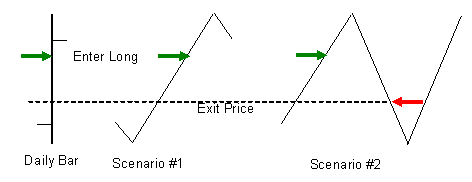日足チャートを用いたシステム(TradeStation用)でバックテストを行うときによく出てくるのがこの問題。
観察の重要性がわかる。
The Breakout Bulletin
ブレイクアウト会報
The following article was originally published in the July 2002 issue of The Breakout Bulletin.
以下の記事はブレイクアウト会報の2002年7月号に掲載されたものです。
Answer to Your Question: Exits on day of entry
質問とその回答:エントリーしたその日にエグジットすること
-
Short term trading on daily bars has certain advantages; notably, you don’t need the expense and hassle of real-time data. However, it also has certain limitations. Recently, I received the same question from two different customers regarding a trade that was stopped out on the day of entry. Even though the trade was stopped out, TradeStation showed the trade still long. I was asked if there was a problem with the MiniMax system logic.
日足バーを使った短期間のトレードには確実に優位な点がある;
はっきりとしているのは、リアルタイムデータにかかる費用と煩わしさが必要でないことだ。
しかしまた、明らかな限界もある。
最近私は、エントリーしたその日にストップによりエグジットされてしまう(ストップアウトされる)トレードについての質問を、異なる2人の顧客から受け取った。
トレードはストップアウトされたのだけれども、トレードステーションはトレードがまだロングのポジションをもったまま(ロングしている)の状態であると表示している、という内容だ。
私はMiniMaxシステム(注:この記事の作者のトレーディングシステム)の論理の問題かどうかを尋ねた。
-
The problem is not with the system. The problem is that TradeStation doesn’t always have enough information on the day of entry when using daily bars to determine if the trade was stopped out that day. Whether a long trade is stopped out or not on the day of entry depends on whether the market declines to your stop price after the trade is entered. If the low of the day is below the stop price, TradeStation has to make an assumption about when this low occurred. All it has to go on is the open-high-low-close. There is no information in a daily bar about the order in which these prices occurred during the day.
この問題はシステムによるものではない。
この問題は、トレードがその日にストップアウトされたかどうかを決定するために日足バーを使用するとき、トレードステーションがエントリーした日に関する十分な情報をもっているとは限らないことである。
ロングのトレードがエントリーしたその日にストップアウトされたかどうかは、トレードがエントリーされた後にマーケットがあなたのストッププライスを拒絶するかどうかに依存している。も
しその日の安値がストッププライスより低ければ、トレードステーションは「この安値がいつ発生したのか」を仮定しなければならない。
仮定しなければならないのは、初値-高値-安値-終値のすべてについてだ。
これらのプライスが日中に発生した順番について、日足バーの中には何の情報もない。
-
Consider the example below.
次の例を考えてみる。
 ← 画像をクリック
← 画像をクリックThe daily bar is shown at left. The day opens near the low and closes near the high. We enter long at the green arrow. One possible scenario for the intraday price movement is shown as Scenario #1. The day moves lower after the open, and puts in the high near the end of day before closing off the high. In this scenario, the market never retests the low of the day, so we’re not stopped out.
日足バーを一番左に表示した。
この日は安値近くで始まり、高値近くで終わっている。
我々は緑の矢印のところでロングでエントリーする。
日中のプライスの動きとしてあり得るシナリオの1つを、Senario#1として表した。
始値の後プライスは安値へと動き、そして高値の勢いがとまる前に、終値近くで高値(最高値)をつける。
このシナリオでは、マーケットはけっしてその日の安値を再び試そうとはしなかったため、我々はストップアウトされなかった。
-
However, Scenario #2 is also possible. Here, the market opens near the low, establishes the high of the day early, puts in the low following the high, and finally moves back up to the close. In this scenario, we’re stopped into the long trade during the first move up and stopped out on the way down to the low. Based solely on the open-high-low-close, it’s impossible to deduce which scenario occurred.
しかしながら、Scenario #2もまたあり得るのである。
マーケットは安値近くで始まり、早くもその日の高値(最高値)をつけ、続いて安値(最安値)をつけ、そして最後に終値へと上昇して戻る。
このシナリオでは、はじめに上昇している間にロングのトレードにストッププライスが設定され、そして安値へと下降しているときにストップアウトされる。
単に初値-高値-安値-終値に基づいてどちらのシナリオが発生したのかを推定するのは不可能である。
-
TradeStation assumes Scenario #1, which is statistically the most likely. Nonetheless, on some days, Scenario #2 will occur. When it does, TradeStation will show the trade is still long at the close, based on assuming the first scenario, even though the trade has been stopped out.
Of course, this is only an issue when the trade is stopped out on the day of entry. On any day following the day of entry, it’s simply a matter of checking to see if the low of the day is below the stop price (or the high is above the stop price for a short exit).
トレードステーションはScenario #1を統計上もっともありそうなこととして仮定する。
それにもかかわらず、いくつかの日にはScenario #2が発生する。
そのときトレードステーションはScenario #1と仮定したうえで、トレードはストップアウトされたのにも関わらずトレードが終値においてまだロングしていると表示する。
もちろん、これはエントリーしたその日にトレードがストップアウトされた時の問題というだけである。エ
ントリーした日以降のすべての日において、その日の最安値がストッププライスより低いかどうか(ショートの場合、エグジットのためのストッププライスより最高値が上にあるか)をみることは、単純な確認事項である。
-
The lack of intraday information can also be a problem if you’re trying to day trade off daily bars. One common source of problems is applying a trailing stop to daily bars when the trade enters and exits on the same day, as it does for a day trading system. You can run into the same problem noted above. It’s possible to use the built-in trailing stop in TradeStation to develop a very impressive day trading system using a very tight trailing stop. Unfortunately, the results might be total fiction.
もしあなたが日足バー上でのデイトレードを終了しようとするとき、日中の情報が欠けていることがまたも問題となりうる。
問題のひとつの共通する要素は、同じ日にトレードのエントリーとエグジットを行うときに、日足バーにデイトレーディングシステム用のトレーリングストップを置いて利用することである。
あなたは前記したのと同じ問題にぶつかるだろう。
とてもきついトレーリングストップを使用したとても印象的なデイトレーディングシステムを開発するために、トレードステーションにあらかじめ入っているトレーリングストップを使うことは可能だ。
しかし残念ながらその結果は全体的に想像上のものだろう。
-
Let’s say, for example, that you’re working on developing a day trading system for the E-mini S&P and decide to run it on daily bars. You choose a trailing stop that waits until you have at least two points of profit then protects half the open profit. This might look great in the TS performance report. Unfortunately, in real trading, most if not all of your trades would be stopped out with one point of profit because it takes very little to move the S&P one point.
例えばあなたがE-mini S&Pのデイトレーディングシステムの開発を行っていて、それが日足バー上で動くものだとする。
少なくとも2ポイントの利益がでるまで待ち、そして現在の利益の半分を守るようなトレーリングストップをあなたは選択する。
このシステムはトレードステーションのパフォーマンスレポート上ではすばらしく見えるだろう。
残念ながら、実際のトレードではS&Pの1ポイント分だけ動くことはとても稀であるため、1ポイントの利益をだしてあなたのトレードがストップアウトされることはほとんどない。
-
However, TradeStation doesn’t know anything about the intraday ups and downs when it only has the daily bar to work with. It uses the assumptions of Scenario #1. This means it assumes the trailing stop for your long trade is in place through the high of the day (see Scenario #1, above) before it starts to calculate the exit point based on protecting half the open profit as the market retraces from the high. In reality, you would have been stopped out long before the market reached the high of the day, even if Scenario #1 was largely correct.
しかしながら、トレードステーションが日足バー上のみで動いているときは、トレードステーションは日中の上下の動きについては何も知らない。
Scenario #1の仮定を使用するのである。これは、マーケットがその日の高値から引き返すときに現在の利益の半分を守ることを基準にしてエグジットポイントを計算し始める前に、あなたのロングのトレード用のトレーリングストップがその日の高値が通過したところに置かれる(上記のScenario #1を参照)、と仮定することを意味している。
現実には、たとえScenario #1がかなり正しいとしても、マーケットがその日の高値をつける前にあなたのロングはストップアウトされる。
-
The lesson from this is simply: if you’re using daily bars and have a lot of trades entering and exiting on the same day, take a careful look at the results to make sure TradeStation is reporting an accurate picture of what’s actually happening in the market.
このことからの教訓は単純である。
すなわち、もしあなたが日足バーを使用していて同じ日にエントリーとエグジットをしたトレードがたくさんあるとしたら、トレードステーションがマーケットで何が実際に起きているのかについての正確な画像を報告していることを確認するために、結果を注意深く観察することである。
終わり
この内容は下記のページを作者の許可を得て翻訳紹介しています。http://www.breakoutfutures.com/Newsletters/Newsletter0702.htm